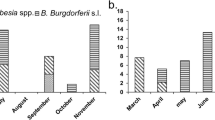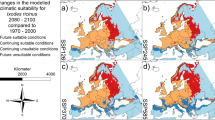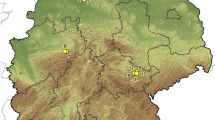Abstract
The impact of climate change on vector-borne infectious diseases is currently controversial. In Europe the primary arthropod vectors of zoonotic diseases are ticks, which transmit Borrelia burgdorferi sensu lato (the agent of Lyme disease), tick-borne encephalitis virus and louping ill virus between humans, livestock and wildlife. Ixodes ricinus ticks and reported tick-borne disease cases are currently increasing in the UK. Theories for this include climate change and increasing host abundance. This study aimed to test how I. ricinus tick abundance might be influenced by climate change in Scotland by using altitudinal gradients as a proxy, while also taking into account the effects of hosts, vegetation and weather effects. It was predicted that tick abundance would be higher at lower altitudes (i.e. warmer climates) and increase with host abundance. Surveys were conducted on nine hills in Scotland, all of open moorland habitat. Tick abundance was positively associated with deer abundance, but even after taking this into account, there was a strong negative association of ticks with altitude. This was probably a real climate effect, with temperature (and humidity, i.e. saturation deficit) most likely playing an important role. It could be inferred that ticks may become more abundant at higher altitudes in response to climate warming. This has potential implications for pathogen prevalence such as louping ill virus if tick numbers increase at elevations where competent transmission hosts (red grouse Lagopus lagopus scoticus and mountain hares Lepus timidus) occur in higher numbers.



Similar content being viewed by others
References
Bolton D (1980) The computation of equivalent potential temperature. Mon Weather Rev 108:1046–1053
Burri C, Cadenas FM, Douet V, Moret J, Gern L (2007) Ixodes ricinus density and infection prevalence of Borrelia burdorferi sensu lato along a north-facing altitudinal gradient in the Rhone valley (Switzerland). Vector Borne Zoonotic Dis 7:50–58
Cadenas FM, Rais O, Jouda F, Douet V, Humair P-F, Moret J, Gern L (2007) Phenology of Ixodes ricinus and infection with Borrelia burgdorferi sensu lato along and north- and south-altitudinal gradient on Chaumont mountain, Switzerland. J Med Entomol 44:683–693
Daniel M (1993) Influence of the microclimate on the vertical distribution of the tick Ixodes ricinus (L.) in Central Europe. Acarologia 34:105–113
Daniels TJ, Falco RC, Fish D (2000) Estimating population size and drag sampling efficiency for the blacklegged tick (Acari: Ixodidae). J Med Entomol 37:357–363
Elston DA, Moss R, Boulinier T, Arrowsmith C, Lambin X (2001) Analysis of aggregation, a worked example: numbers of ticks on red grouse chicks. Parasitology 122:563–569. doi:10.1017/S0031182001007740
Gilbert L, Jones LD, Hudson PJ, Gould EA, Reid HW (2000) The role of small mammals in the persistence of louping-ill virus: field survey and co-feeding studies. Med Vet Entomol 14:278–283
Gray JS (1998) The ecology of ticks transmitting Lyme borreliosis. Exp Appl Acarol 22:249–258
Gray JS, Lohan G (1982) The development of a sampling method for the tick Ixodes ricinus and its use in a redwater fever area. Ann Appl Biol 101:421–427
Health Protection Scotland (2009) http://www.documents.hps.scot.nhs.uk/giz/10-year-tables/lyme.pdf (last accessed March 2009)
Hester AJ, Gordon IJ, Baillie GJ, Tappin E (1999) Foraging behaviour of sheep and red deer within natural heather grass mosaics. J Appl Ecol 36:133–146
Hudson PJ (1992) Grouse in space and time. Game Conservancy Trust, Fordingbridge
Jones LD, Gaunt M, Hails RS, Laurenson K, Hudson PJ, Reid H, Henbest P, Gould EA (1997) Transmission of louping-ill virus between infected and uninfected ticks co-feeding on mountain hares. Med Vet Entomol 11:172–176
Jouda F, Perret J, Gern L (2004) Ixodes ricinus density and distribution and prevalence of Borrelia burgdorferi sensu lato infection along an altitudinal gradient. J Med Entomol 41:162–169
Kirby AD, Smith AA, Benton TG, Hudson PJ (2004) Rising burden of immature sheep ticks (Ixodes ricinus) on red grouse (Lagopus lagopus scoticus) chicks in the Scottish uplands. Med Vet Entomol 18:67–70
Laurenson MK, Norman RA, Gilbert L, Reid HW, Hudson PJ (2003) Identifying disease reservoirs in complex systems: mountain hares as reservoirs of ticks and louping-ill virus, pathogens of red grouse. J Anim Ecol 72:177–185
Lindgren E, Gustafson R (2001) Tick-borne encephalitis in Sweden and climate change. Lancet 358:16–18
Lindgren E, Tälleklint L, Polfeldt T (2000) Impact of climatic change on the northern latitude limit and population density of the disease-transmitting European tick Ixodes ricinus. Environ Health Perspect 108:119–123
MacLeod J (1935) Ixodes ricinus in relation to its physical environment. II. The factors governing survival and activity. Parasitology 27:123–144
Perret JL, Guigoz E, Rais O, Gern L (2000) Influence of saturation deficit and termperature on Ixodes ricinus tick questing activity in a Lyme borreliosis-endemic area (Switzerland). Parasitol Res 86:554–557
Randolph SE (2001) The shifting landscape of tick-borne zoonoses: tick-borne encephalitis and Lyme borreliosis in Europe. Phil Trans R Soc Lond B 356:1045–1056
Randolph SE (2004) Tick ecology: processes and patterns behind the epidemiological risk posed by ixodid ticks as vectors. Parasitology 129:S1–S29
Randolph SE (2009) Perspectives on climate change impacts on infectious diseases. Ecology 90:927–931
Randolph SE, Storey K (1999) Impact of microclimate on immature tick-rodent host interactions (Acari: Ixodidae): implications for parasite transmission. J Med Entomol 36:741–748
Reid HW (1975) Experimental infection of the red grouse with louping-ill virus (Flavivirus group). I. The viraemia and antibody response. J Comp Pathol 85:231–235
Scharlemann JPW, Johnson PJ, Smith AA, Macdonald DW, Randolph SE (2008) Trends in ixodid tick abundance and distribution in Great Britain. Med Vet Entomol 22:238–247
Watts EJ (2007) The role of host and habitat spatial heterogeneity in the distribution of ticks and tick-borne diseases in the Scottish uplands. Ph.D. thesis, University of Aberdeen
Wilson K (2009) Climate change and the spread of infectious ideas. Ecology 90:901–902
Zeman P, Beneš C (2006) A tick-borne encephalitis ceiling in Central Europe has moved upwards during the last 30 years: possible impact of global warming? Int J Med Microbiol 293(Suppl 37):48–54
Acknowledgements
I am extremely grateful to Scot Ramsay for helping organise and conduct field work, Antonio Rodriguez and Julien Barlet for fieldwork assistance, and the land owners and managers for permission to access field sites. I thank Jim McLeod for assimilating spatial environmental data, Jackie Potts, Mark Brewer and David Elston for invaluable statistical advice, Colin Beale and David Johnson for help with graphics and Jack Lennon and three anonymous referees for comments on the manuscript. This research was funded by the Scottish Government, Rural and Environment Research and Analysis Directorate.
Author information
Authors and Affiliations
Corresponding author
Additional information
Communicated by R. Brandl.
Rights and permissions
About this article
Cite this article
Gilbert, L. Altitudinal patterns of tick and host abundance: a potential role for climate change in regulating tick-borne diseases?. Oecologia 162, 217–225 (2010). https://doi.org/10.1007/s00442-009-1430-x
Received:
Accepted:
Published:
Issue Date:
DOI: https://doi.org/10.1007/s00442-009-1430-x




